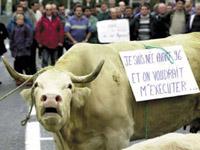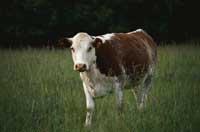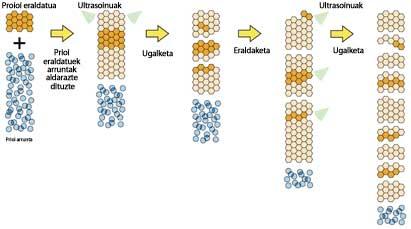Mad cows, sample of man's madness
2001/01/01 Kortabarria Olabarria, Beñardo - Elhuyar Zientzia Iturria: Elhuyar aldizkaria
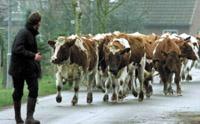
Territoriality is not the only limitation that has gone through bovine disease, since in 1996 the death of 4 people was announced as a result of bovine spongiform encephalopathy, the new version of Creutzfeldt-Jakob disease. That is, mad cow disease, bovine spongiform encephalopathy, became the new human version of Creutzfeldt-Jakobenfermedad. Therefore, he was able to overcome the boundary between species. The greatest concern comes from there, will man transmit the disease to man?
Before trying to answer the question, it is necessary to launch the problem. Bovine spongiform encephalopathy is not a new disease, cases prior to 1985 are collected. In fact, their own spongiform encephalopathies affect all species, but in a very small number. All of them are degenerative diseases of the nervous system, communicable dementias, caused by prions, special proteins subjected to mutation. That is why, because they are very rare and rare diseases, until in 1985 the first cases of mad cow disease appeared in England, neither scientists nor authorities paid much attention.
The first traces of the problem have been located at the London Zoo, but it was detected among the milk cows.
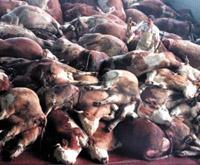
Faced with the need for market demand, the life of beef cows barely exceeds 2 years and the disease itself takes longer to develop, while the life of milk cows is longer, so milk cows were affected by it. The scientists immediately went to work and soon released the source of the disease: feeding the cows, more specifically the flours with remains of sick sheep. Due to the disease of sheep scrapie or the vibration of sheep, in 1979 the Icelanders advised the English to be careful with this type of food. Despite the warnings, until July 1988 in Britain this type of food was not banned for now. The non-adoption of measures was then decisive for the extension of the disease, since it was introduced in the recycling cycle, that is, healthy sheep fed food made with sick scrapie sheep, which later killed and introduced them into cow food. Therefore, it seems that for the prions of adaptation to the new species it was essential to be in contact throughout the cycle with other prions.
However, food based on these flours was an ancestral issue in Brittany. Why didn't any disease appear until then? For many experts, the blame was on the government of Margaret Tatcher. As was the time of the oil crisis, the government to advance the money decided to lower the temperature of the manufacturing process of these flours, where the prions responsible for the disease had been transformed. In addition, it should be noted that in 1976 scrapie disease was caused by a vaccine, but as its declaration was not necessary, a large number of sick sheep were introduced into the food chain. It was included in the list of diseases to be declared in 1993 when it was discovered that it could have something to do with mad cow disease.
In July 1988 there was a ban on using these flours in food in Britain, a disease for the mandatory declaration of bovine spongiform encephalopathy by 1990, which did not solve the problem but worsened it. What did Britain have to do with its remains of flesh? It was a serious economic problem. The recycling of these products is an immense industry that, in addition to supporting the slaughterhouse industry itself, solves the problem of waste. Britain found no better solution than selling its flour out. Due to the invasion of several European countries, mad cow disease surpassed Britain's borders. Since then, prohibitions were established in Europe to sell these flours and European countries began to sell outside.
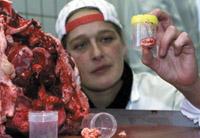
The real scandal was born in 1996. The British newspaper Daily Mirror published, in anticipation of the government, that some young people died from a new version of Creutzfeldt-Jakob syndrome. The situation was very rare because all the dead were under 40 years old. Studies revealed a worrying fact: three of the dead were ranchers and had cases of mad cows among their animals. In September 1997, scientists issued a judgment: "It is a mad cow disease, transmitted to man." Not surprisingly, Creutzfeldt-Jakob disease is of prionist origin and prions are able to overcome the border between species.
In turn, the countries of the world closed the door to the British cow market, which then did the same with those of the European country.
The remains of slaughterhouses have been totally prohibited in food, nor can they be part of fertilizers, nor of food and cosmetics for children, although until now they have existed. The debate and the latest measures are more demanding. Hence the question arises: What about all those remains? It is difficult to answer. You can not burn them all, besides having a large mass that generates terrible contamination, because nobody knows if the process is safe or not. Burning waste can be more dangerous than others. The challenge is there. It is not just about stopping the disease, which at the moment is totally impossible, since prions cannot be destroyed, but rather to prevent the prion from being recycled among humans.
It seems that if it is not related to prions, that is, you do not eat meat from sick cows, you cannot get sick. However, experts are concerned that they believe there are more ways of transmission, such as blood. If the predictions of the pessimists had been fulfilled, the evil of mad cows would already become an epidemic. Fortunately, it seems that it has not yet happened.

Gai honi buruzko eduki gehiago
Elhuyarrek garatutako teknologia



